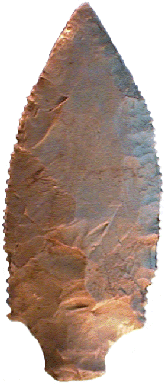

Point Type: MULBERRY
CREEK
Also See: Benton, Ledbetter Stemmed, Little
Bear Creek, Maples, Pickwick, Pontchartrain
Location: Southeastern United States
Associated Dates:
5000 - 3000 B.P. - Late Archaic to Woodland
Morphology: Stemmed
General Description: The Mulberry Creek type is a medium to large sized, thick, stemmed point with recurved blade edges. The shoulders are narrow and usually tapered but can be barbed. The shoulders can be asymmetrical. The blade is the widest part, usually at the midportion of the projectile. The type often has fine serrations on both blade edges. The distal end is usually acute. The stem can be straight or contracting but is rarely expanding. The stem was formed by removing a pair of broad, opposing, midpoint angled percussion flakes from each side of the preform. The stem was then finished by removing a few elongate or steep pressure flakes from the basal and side edges. The basal edge is usually convex but may be straight and is poorly thinned. The stem edges are usually ground. The cross-section is biconvex.
Broad shallow random flaking was used to shape the faces. Then fine retouch was carried out along the blade edges. The stem edges were usually more crudely retouched.
The size of the Mulberry Creek point ranges from 68 mm to 116 mm in length, with the blade width being between 22 and 40 mm and stem length being between 12 mm and 16 mm. Typical thickness is between 9 and 12 mm. The point was named by David L. DeJarnette for examples which he recovered from sites along the Mulberry Creek in Colbert County, Alabama.
About the Point Above: The very large Mulberry Creek blade pictured at the top of this page, was found near the town of Clifton in Wayne County, Tennessee. The point is made from light gray and tanish colored flint with rust colored inclusions and heavy patination. The edges are very finely serrated but are almost totally worn down from use near the tip of the blade. Overall, the point measures 100 mm in length, is 39 mm wide across at mid blade and is 11 mm thick in mid blade just above the shoulders. The stem is 14 mm long and 17 mm wide. The stem thickness is 7 mm. Due to the use wear on the tip of this blade and its very large size, presumably, it served some use as a knife blade. Catalog Number 19-85-D
References: Baker, Cambron & Hulse, Justice, Overstreet, Puckett (1)
© Copyright 1997 - 2008 LITHICS-Net WWW.LITHICSNET.COM
Use your Browser's BACK Button to return to the LITHICS-Net Index.